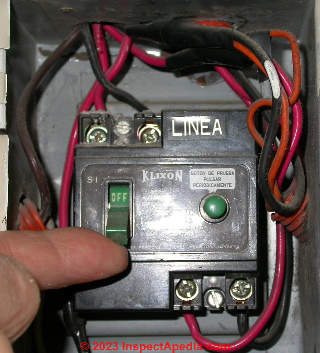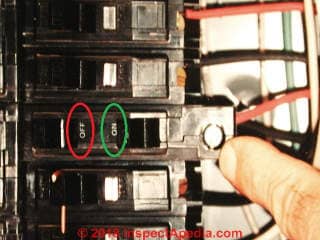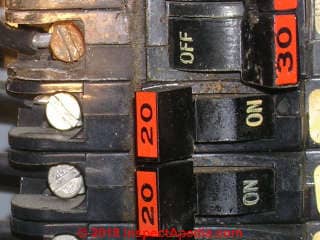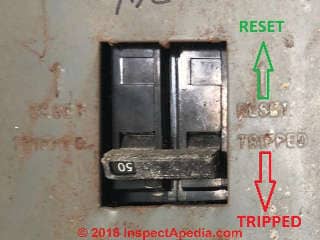 Electrical Circuit Breaker Trip & Reset
Electrical Circuit Breaker Trip & Reset
How to re-set a tripped circuit breaker
- POST a QUESTION or COMMENT about unsafe electrical circuit breakers and types or modes of circuit breaker failures
Electrical Circuit Breaker Tripped - power is off: how to re-set a breaker.
This article describes the simple procedure to turn electrical power back on when a circuit breaker has tripped.
We also discuss the causes of tripped circuit breakers and what to do if a breaker keeps-on switching off.
InspectAPedia tolerates no conflicts of interest. We have no relationship with advertisers, products, or services discussed at this website.
- Daniel Friedman, Publisher/Editor/Author - See WHO ARE WE?
Electrical Circuit Breaker Tripped Off

 How to re-set or "reactivate" a tripped circuit breaker
How to re-set or "reactivate" a tripped circuit breaker
Photos: with cover removed on this main electrical panel in Buenos Aires you can see that it would be too easy to accidentally touch a live electrical terminal or wire. [Click to enlarge any image]
Our first photo shows the green main toggle circuit breaker in the UP or SI (yes) or "ON" position.
[Click to enlarge any image]
Our second photo shows the green toggle switch in the DOWN or OFF or No position. When a circuit breaker switch has "tripped" in response to a short circuit or overcurrent, it will usually be in the middle between ON and OFF.
Watch out: in the photos above, opening the door to give access to the circuit breaker in this type electrical panel exposes electectrially-live screws and wires that, if touched, could cause a dangerous shock. Turning off all electrical power before exposing live components to touch is the only way to completely avoid the danger.
Fatal Shock Hazard Warning: Inspecting electrical components and systems risks death by electrocution as well as serious burns or other injuries you or to others. Do not remove the cover from an electrical panel to expose live wires and connections unless you are properly trained and equipped.
How To re-set a circuit breaker
- First switch the toggle to fully the OFF position. Some breakers must be pushed past the OFF position to a RESET position as we show in drawings at the top of this page & also below.
- Then move the switch to the ON position.
Watch out: if the breaker switch trips back to its middle or "TRIPPED" position, thus turning electrical power off to the circuit, leave it off. An unsafe condition is present on the circuit or in an electrical device connected to the circuit. If you try to force power on you risk a building fire or an electric shock.
Continuing below, this article gives details about the what, when, where, how and why circuit breakers trip off and how to re-set various types of breakers. If your electrical panel uses fuses instead of toggle-switches (breakers) see BLOWN FUSE REPLACEMENT.
How to Find the Tripped Circuit Breaker
 Watch out: never reach-into nor touch metal parts, screws, wires, terminals inside an electrical panel: doing so could kill you.
Watch out: never reach-into nor touch metal parts, screws, wires, terminals inside an electrical panel: doing so could kill you.
Don't even touch an electrical panel if you are standing in water or if you see arc, burns or other signs of unsafe conditions at the panel. Instead, call for help from a licensed electrician.
However user switches that toggle circuit breakers on and off in the electrical panel are intended to be safe for use by occupants.
Find the electrical panel, open its access cover. This should be a hinged door. You should not have to remove screws to find the circuit breaker switches.
Look at the toggle switches in the panel. Normally all or most circuit breaker switches will be in the ON position.
Look for a toggle switch that is mid-way between ON and OFF - this is a switch that has tripped and is off internally.
One of four circuit breaker OFF or TRIPPED positions may apply depending on the brand, age, and model of your circuit breakers and panel
- Tripped breaker switch is in center position (as in our drawing above) and is reset by moving it past OFF to RESET, then to ON
- Tripped breaker is in an ambiguous position but shows a red TRIPPED FLAG in a window on the breaker body and is reset by moving it to OFF, then ON
- Tripped breaker may have moved to the full OFF position and is reset by moving it to ON
- Tripped breaker is in the OFF position and is reset by PUSHING the TOGGLE IN to reset it to ON
Try moving that switch first to the RESET position, then to the ON position. Just pushing the tripped breaker from TRIPPED to ON usually won't work. Move it first to OFF or RESET, then to ON.
If you don't see any circuit breaker switches that appear to be tripped, you can try turning individual breaker switches OFF, waiting a moment, then switching the breaker back to the ON position.
Watch out: you may be turning on or off building equipment that you don't want to interrupt such as life-safety equipment, breathing apparatus (in some homes), as well as air conditioners and refrigerators.
Watch out: if the circuit breaker is loose and wobbling in its mount in the electrical panel it is unsafe. It may simply need to be re-mounted or pushed into position inside the panel, or a mounting screw may be loose, or the panel may be damaged.
These repairs require removing the electrical panel cover - not something you should attempt if you are not trained in safe electrical repairs as touching a live connection in the panel can shock or kill you.
Which Way is OFF and Which Way is ON for Circuit Breaker Toggle Switches
 The answer depends on the individual circuit breaker panel design.
The answer depends on the individual circuit breaker panel design.
In good design and by convention, up-and down electrical switches in general are usually ON when switched UP and OFF when switched DOWN but not all electrical panels will have the breakers in this arrangements.
In most electrical panel breakers, while the main breaker may move up and down, most of the circuits are switched ON or OFF horizontally - as in my photo.
Look at the circuit breaker itself to see if it has an ON and OFF position marked on the breaker body - many, like the breaker in my photo, have ON and OFF marked right on the circuit breaker.
Look at the electrical panel around the breaker switch: many panels have an ON or OFF stamped into the steel of the electrical panel front.
[Click to enlarge any image]
Other circuit breakers will show only one of the breaker's two states, such as OFF when the breaker is OFF - as with these (unsafe) FPE circuit breakers below:
Below:
These GE-branded FPE circuit breakers (unsafe) are in a panel on whose face the TRIPPED position has been embossed.
What Causes a Circuit Breaker to Trip OFF
When a circuit breaker has switched OFF one of two unsafe conditions has occurred: there is either a short circuit or an overload condition.
The circuit breaker uses an internal device, usually taking advantage of the heat generated by an electrical current, to snap the circuit breaker switch open when there is too much current (too much heat).
Why? Because if too much electrical current flows through a wire or device the wire or device can become hot enough to start a building fire. "Too much" or "too hot" conditions can occur in just a moment if there is a short circuit, or these conditions can occur minutes or longer if the circuit is overloaded.
Problem: a short circuit has occurred
A short circuit occurs when a live or hot wire has contacted ground, or earth, or a neutral wire causing rapid flow of very high electrical current - this trips off the circuit breaker in a fraction of a second
Solutions
- If the tripped breaker was supplying lighting or an individual appliance like an electric range or air conditioner,
leave the circuit off - the circuit or appliance is unsafe and needs inspection and repair by a trained electrician - if the tripped breaker was supplying a string of electrical receptacles,
unplug everything that was connected to that circuit, then try re-setting the circuit breaker
turn the breaker back on
if the breaker trips OFF again then the defect is in the circuit itself, it is unsafe, and it should be left off while you call for help from an electrician
If the breaker remains ON then the defect is in one of the devices that was connected to the circuit. you can try them one by one.
Examples: a floor lamp with a short in its wiring or in its bulb socket will create a short circuit that trips the breaker; a coffee maker with an internal short circuit will trip the circuit breaker.
Problem: the circuit is overloaded
An electrical circuit overload occurs when too many things are running on an individual electrical circuit, drawing too much electrical power (current, or amps). If the total load in amps on a circuit exceeds the amp-rating of the fuse or circuit breaker, this will trip off the circuit breaker but usually only after the connected items have been on for a time.
Solution:
- Short term solution: unplug the devices connected to the circuit, or for a lighting circuit, turn off the lights connected to the circuit, then try turning on just one or a few of them.
- Better solution: divide up the electrical load by moving some of of the connected devices or appliances to another circuit.
- Best solution: add electrical circuits in areas where you need to have more devices or appliances connected
Replace a Defective Circuit Breaker?
If an individual circuit breaker is faulty and trips off when it should not, it can usually be replaced by a licensed electrician or, where permitted, by a person trained in safe electrical repairs.
Fatal Shock Hazard Warning: Inspecting electrical components and systems risks death by electrocution as well as serious burns or other injuries you or to others. Do not remove the cover from an electrical panel to expose live wires and connections unless you are properly trained and equipped.
However some electrical panel and circuit breaker brands have particularly poor or unsafe performance records. If your electrical panel is one of those, it should be replaced entirely because it is not giving you the safety protection upon which you rely to avoid a building fire or electrical shock injury.
At CIRCUIT BREAKER RELIABILITY TESTS you can see independent test results showing a dramatic difference in safe performance among a variety of major circuit breaker and electrical panel brands.
In addition several known brands of panel should be replaced:
- CHALLENGER ELECTRIC PANELS
- CIRCUIT BREAKERS RE-CONDITIONED USED
- FPE Stab-Lok® : FIRES WAITING TO HAPPEN
- MURRAY CIRCUIT BREAKER HAZARDS
- MURRAY SIEMENS Recall
- PRIVATE BRAND/ EMI FPE PANELS
- PUSHMATIC - BULLDOG PANELS
- UBI FPE CIRCUIT BREAKER TEST RESULTS
- ZINSCO CIRCUIT BREAKER TEST REPORT
...
Continue reading at CIRCUIT BREAKER RELIABILITY TESTS or select a topic from the closely-related articles below, or see the complete ARTICLE INDEX.
Or see these
Recommended Articles
- AFCIs ARC FAULT CIRCUIT INTERRUPTERS
- CIRCUIT BREAKER FAILURE RATES
- CIRCUIT BREAKER / FUSE INSPECTION
- CIRCUIT BREAKER LOCKS
- CIRCUIT BREAKER HANDLE TIES
- CIRCUIT BREAKER MAIN or FUSE TEST
- CIRCUIT BREAKER REPLACEMENT
- CIRCUIT BREAKER RESET STEPS
- CIRCUIT BREAKERS RE-CONDITIONED USED
- CIRCUIT BREAKER RELIABILITY TESTS
- CIRCUIT BREAKER SIZE for A/C or HEAT PUMP
- GFCI PROTECTION, GFCI CODES
- GFCI DEVICE SELECTION & WIRING
- GFCI TEST PROCEDURES
- MOBILE HOME ELECTRICAL GFCI DIAGNOSIS
Suggested citation for this web page
CIRCUIT BREAKER RESET STEPS at InspectApedia.com - online encyclopedia of building & environmental inspection, testing, diagnosis, repair, & problem prevention advice.
Or see this
INDEX to RELATED ARTICLES: ARTICLE INDEX to ELECTRICAL INSPECTION & TESTING
Or use the SEARCH BOX found below to Ask a Question or Search InspectApedia
Ask a Question or Search InspectApedia
Questions & answers or comments about unsafe electrical circuit breakers and types or modes of circuit breaker failures.
Try the search box just below, or if you prefer, post a question or comment in the Comments box below and we will respond promptly.
Search the InspectApedia website
Note: appearance of your Comment below may be delayed: if your comment contains an image, photograph, web link, or text that looks to the software as if it might be a web link, your posting will appear after it has been approved by a moderator. Apologies for the delay.
Only one image can be added per comment but you can post as many comments, and therefore images, as you like.
You will not receive a notification when a response to your question has been posted.
Please bookmark this page to make it easy for you to check back for our response.
IF above you see "Comment Form is loading comments..." then COMMENT BOX - countable.ca / bawkbox.com IS NOT WORKING.
In any case you are welcome to send an email directly to us at InspectApedia.com at editor@inspectApedia.com
We'll reply to you directly. Please help us help you by noting, in your email, the URL of the InspectApedia page where you wanted to comment.
Citations & References
In addition to any citations in the article above, a full list is available on request.
- ..
- "Electrical System Inspection Basics," Richard C. Wolcott, ASHI 8th Annual Education Conference, Boston 1985.
- "Home Wiring Inspection," Roswell W. Ard, Rodale's New Shelter, July/August, 1985 p. 35-40.
- "Evaluating Wiring in Older Minnesota Homes," Agricultural Extension Service, University of Minnesota, St. Paul, Minnesota 55108.
- In addition to citations & references found in this article, see the research citations given at the end of the related articles found at our suggested
CONTINUE READING or RECOMMENDED ARTICLES.
- Carson, Dunlop & Associates Ltd., 120 Carlton Street Suite 407, Toronto ON M5A 4K2. Tel: (416) 964-9415 1-800-268-7070 Email: info@carsondunlop.com. Alan Carson is a past president of ASHI, the American Society of Home Inspectors.
Thanks to Alan Carson and Bob Dunlop, for permission for InspectAPedia to use text excerpts from The HOME REFERENCE BOOK - the Encyclopedia of Homes and to use illustrations from The ILLUSTRATED HOME .
Carson Dunlop Associates provides extensive home inspection education and report writing material. In gratitude we provide links to tsome Carson Dunlop Associates products and services.



